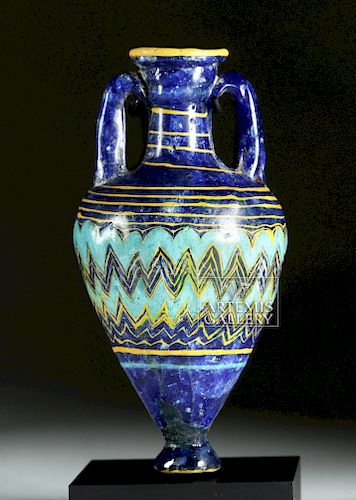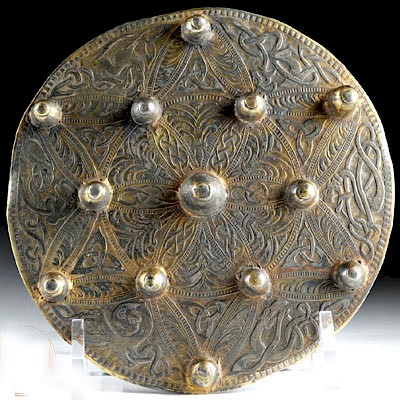Gorgeous Greek Core-Form Glass Amphoriskos
Lot 13
About Seller
Artemis Fine Arts
686 S Taylor Ave, Ste 106
Louisville, CO 80027
United States
Selling antiquities, ancient and ethnographic art online since 1993, Artemis Gallery specializes in Classical Antiquities (Egyptian, Greek, Roman, Near Eastern), Asian, Pre-Columbian, African / Tribal / Oceanographic art. Our extensive inventory includes pottery, stone, metal, wood, glass and textil...Read more
Estimate:
$7,000 - $9,000
Absentee vs Live bid
Two ways to bid:
- Leave a max absentee bid and the platform will bid on your behalf up to your maximum bid during the live auction.
- Bid live during the auction and your bids will be submitted real-time to the auctioneer.
Bid Increments
| Price | Bid Increment |
|---|---|
| $0 | $25 |
| $300 | $50 |
| $1,000 | $100 |
| $2,000 | $250 |
| $5,000 | $500 |
| $10,000 | $1,000 |
| $20,000 | $2,500 |
| $50,000 | $5,000 |
| $100,000 | $10,000 |
| $200,000 | $20,000 |
About Auction
By Artemis Fine Arts
Jul 19, 2018
Set Reminder
2018-07-19 10:00:00
2018-07-19 10:00:00
America/New_York
Bidsquare
Bidsquare : Fine Antiquities/Ethnographic Art
https://www.bidsquare.com/auctions/artemis-gallery/fine-antiquities-ethnographic-art-3329
Featuring classical antiquities, ancient and ethnographic art from cultures encompassing the globe, plus fine art. Artemis Fine Arts info@artemisgallery.com
Featuring classical antiquities, ancient and ethnographic art from cultures encompassing the globe, plus fine art. Artemis Fine Arts info@artemisgallery.com
- Lot Description
Ancient Greece, Classical period, ca. 5th century BCE. A stunning example of a core-formed glass amphoriskos once used to hold scented oils. The near-miniature vase boasts an exceptionally elegant form with an ovoid body that is finely contoured with vertical ribs, twin handles that gracefully join the shoulder to the cylindrical neck, and an everted discoid rim, all upon a slightly splayed foot. The decoration of this piece is simply gorgeous, with the cobalt blue body wound with azure and golden yellow thread-like trails applied in a close-knit zigzag or feathered pattern. The golden trails continue above the feathered pattern - encircling the neck as well as the rim - as well as beneath the feathering and below the base. An opulent example of glass-working to be treasured for its sumptuous form, lustrous sheen, fabulous hues, and sophisticated technique. Custom museum-quality display stand included. Size: 1.875" W x 3.75" H (4.8 cm x 9.5 cm); 4.3" H (10.9 cm) on included custom stand.
According to the Corning Museum of Glass, core forming is "the technique of forming a vessel by winding or gathering molten glass around a core supported by a rod. After forming, the object is removed from the rod and annealed. After annealing, the core is removed by scraping" (https://www.cmog.org/glass-dictionary/core-forming). This process of glass making was begun in the late 16th century BCE by glassmakers of Mesopotamia, and then adopted by Egyptian glassmakers in the 15th century BCE. The technique almost came to an end in the so-called Dark Ages of Mediterranean civilization (1200 to 900 BCE); however, by the 9th century BCE a new generation of glassmakers took up the technique once again, and between the 6th and 4th century BCE core-forming spread throughout the Mediterranean.
A similar example hammered for $6,250 at Christie's, New York Antiquities Auction (sale 2856, June 5, 2014, lot 40): https://www.christies.com/lotfinder/ancient-art-antiquities/an-eastern-mediterranean-core-formed-glass-amphoriskos-circa-5800551-details.aspx?from=searchresults&intObjectID=5800551&sid=3189dc20-b233-485f-878b-67d6274070e8
Provenance: private East Coast, USA collection
All items legal to buy/sell under U.S. Statute covering cultural patrimony Code 2600, CHAPTER 14, and are guaranteed to be as described or your money back.
A Certificate of Authenticity will accompany all winning bids.
We ship worldwide and handle all shipping in-house for your convenience.
#133152Repaired from multiple pieces with small areas of restoration along break lines. Surface wear and abrasions commensurate with age as expected, minute nicks to base, body, handles, and neck, with fading to some pigmentation. Light earthen deposits within recessed areas.Condition
- Shipping Info
-
All shipping is handled in-house for your convenience. Your invoice from Artemis Gallery will include shipping calculation instructions. If in doubt, please inquire BEFORE bidding for estimated shipping costs for individual items.
-
- Buyer's Premium



 EUR
EUR CAD
CAD AUD
AUD GBP
GBP MXN
MXN HKD
HKD CNY
CNY MYR
MYR SEK
SEK SGD
SGD CHF
CHF THB
THB
















